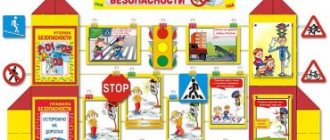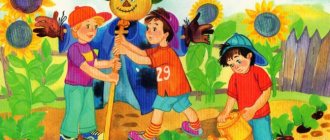Child safety in kindergarten
Our children are our future... This is a well-known truth, especially taking into account the social values of our state. But at the same time, we constantly hear about various emergencies that happen to children in certain educational institutions. Who is responsible for them? How and by whom is the safety of children ensured, for example, within the walls of kindergartens? Let's understand the material.
Who provides security and is responsible?
Kindergarten pupils have the right to protection of life and health during the educational process <*>. The responsibility to create a safe environment lies with the educational institution, i.e. on its employees, under whose control and supervision children are <*>. In kindergarten it is:
- a preschool teacher ( educator ), who is personally responsible for creating a safe environment when organizing the educational process. He must comply with the rules for protecting the life and health of children; established fire safety requirements, etc.; must know the basics of first aid;
- assistant teacher , who must know the rules and regulations for protecting the life and health of students; sanitary and hygienic standards for the maintenance of premises, equipment, inventory; first aid rules; fire safety rules and regulations, etc.
Note In practice, as a rule, for one group of pupils there are two teachers working in shifts and one assistant teacher. That is, direct control and supervision of children is carried out simultaneously by two people . At the same time, the teacher always bears personal responsibility for the children. Along with him, the assistant teacher is also responsible if the children remain only under his control, and at night in kindergartens with children staying around the clock, he bears full responsibility;
- the head of the kindergarten , who is responsible for the results of the activities of the educational institution; for life and health, respect for the rights and freedoms of children during the educational process; takes measures to create safe and favorable learning and upbringing conditions for children; ensures compliance with fire safety rules and regulations, etc.
Note! The following persons do not have the right to work with children: - those with a criminal record - until it is expunged or withdrawn; - those deprived of the right to engage in teaching activities; - those who have ever committed crimes against sexual integrity or sexual freedom or some others <*>; - those who have not passed preliminary preventive drug examination <*>.
Thus, as soon as you brought your child to kindergarten and handed him over to the teacher or his assistant, the kindergarten staff bears responsibility for your child. The child is in their area of responsibility until the moment when he returns under your direct control , i.e. when you are close to the child and can control him (for example, hold his hand).
Note: Situations are possible when a child sees his mother “on the horizon” and runs towards her; or they called him on the phone and said that they would pick him up soon, and the child went to the locker room to get dressed; or he himself decided that it was time to go home and left the group on his own. If something happened to him at this time (fell, hit, got hit by a car), responsibility will be borne by the persons under whose control and supervision the child was or should have been. In all the above situations, these are teachers and their assistants.
How security is ensured
The comprehensive safety of kindergarten students usually includes:
— fire safety measures;
— measures to ensure sanitary and epidemiological well-being;
— measures to ensure the safety of children’s lives and health;
— occupational health and safety measures;
— electrical safety measures;
— civil defense activities (training of administration and personnel);
— anti-terrorism security measures.
Authorized state bodies and organizations are responsible for compliance by the kindergarten administration with safety requirements in each of the listed areas (for example, education departments of district administrations, state fire inspection bodies, state sanitary inspections, internal affairs bodies, etc.). As part of their activities, they issue mandatory rules, instructions, regulations, etc. Compliance with these standards is verified through inspections and other activities. At the same time, in practice, it is quite difficult for parents to make sure that all these norms are actually observed.
However, parents also have other opportunities to influence the safety of children in kindergarten. Some measures and measures to ensure safety are not prescribed anywhere, but can be introduced by the head at the level of a particular kindergarten at the suggestion of parents or on their own initiative. It is desirable that these measures be implemented in a comprehensive manner. The reason for their introduction, as a rule, is various emergencies, news of which spreads quite quickly. Here are some of these measures.
Access mode or “trusted person system”
Only so-called authorized persons can pick up a child from kindergarten. And this is not just a circle of people whom the child has recognized and with whom he is ready to leave, for example, relatives, neighbors or acquaintances. First of all, such persons include the legal representatives of the child , i.e. his parents, adoptive parents, guardians, trustees <*>.
Note: In practice, there are cases when a teacher should check even a legal representative. For example, the child’s parents are divorced and the child permanently lives with his mother, who always picks him up. If the father suddenly comes to pick up the child, the teacher is advised to call the mother and find out if she allows the child to go with him.
Trusted persons, in turn, can entrust other persons, in particular grandparents, adult brothers and sisters, to pick up the child from kindergarten.
Note : In practice, as a rule, such trust is formalized by writing a power of attorney, which is given to the teacher along with a copy of the proxy’s passport and stored on the premises of the kindergarten.
In some kindergartens, a special pass is issued for each authorized person, without which they will not only not be given the child, but will not even be allowed into the territory of the kindergarten.
CCTV
This measure may help:
— to recreate the picture of the emergency that occurred, determine the culprit, and the location of the responsible persons;
— detect children left unattended;
— track the direction of the child’s movement if he left the kindergarten territory on his own;
- expel unauthorized persons from the territory of the kindergarten or identify them by image if they have committed illegal actions, etc.
At the same time, organizing competent video surveillance throughout the kindergarten is an expensive undertaking. Often educational institutions themselves cannot afford such expenses. Typically, parents of kindergarten students or, less commonly, other individuals purchase the necessary equipment as sponsorship. In addition, video cameras and other equipment must not only be installed, but also maintained.
Note: This measure is good if certain conditions are met, in particular: - cameras must always be in working order; - it is possible to view the image on any of the displays included in the system; - there is an employee on an ongoing basis authorized to monitor the image from the cameras (watchman , security guard);— camera recordings are stored on the server for a certain period of time;— it is possible to search for images by date and time of recording, as well as enlarge selected images or their fragments, print individual frames, etc.
Non-free entry and exit
This measure can prevent:
— the presence of unauthorized persons on the territory with unclear intentions;
- the appearance on the territory of the kindergarten of objects and things that can cause harm to the child (syringes, needles, firecrackers, lighters, broken glass, cans, etc.);
- walking dogs that can scare or bite children, etc.
This is implemented by installing locking devices at the entrances (doors, gates, gates) to the kindergarten. They are open only during the arrival and departure of pupils, usually from 7 to 9 and from 16 to 19 hours. In some gardens, entry is made by calling the gate, when a security guard (watchman) opens it remotely.
It also makes sense to install locking devices with a latching mechanism at the entrances to the kindergarten building. Then the door will open from the inside and outside after pressing a button, which is at the height of an adult. In this case, it is possible to prevent children from going outside unaccompanied by adults.
Preventive activities involving children
They are conducted by employees of the Ministry of Emergency Situations and the Department of Internal Affairs in the form of lectures and practical exercises for the benefit of children and adults. During events:
— will tell you about the rules for handling fire and flammable objects;
— will teach rules of behavior on the road and on the street;
— they will explain in an accessible form for children how not to get lost on the street and in the crowd, how to behave with strangers;
— remind adults about the dangers of leaving children unattended, etc.
These events are carried out both as part of our own actions and at the request of kindergarten administrations.
Useful gadgets
In the 21st century it is impossible not to take advantage of high technologies. Modern gadgets not only have entertaining, educational, and service functions, but they can also help in a dangerous situation or prevent this situation from happening.
For example, a smart children's watch with GPS will help:
— track the child’s movements throughout the day;
- make calls to him;
— fence off the area, when a child leaves it a notification will be sent;
- listen to what is happening around the child.
Also, the child himself can call his parents and talk on speakerphone or, by pressing the SOS button, notify about the danger. The undoubted advantage is that the watch is always with the child; it is not as easy to lose as a phone, because it is fixed on the wrist. In addition, the child himself will not be able to turn them off (according to the manufacturer), and some have a special sensor that will notify the parent when the watch is removed. These watches can be used from the age of 3 years.
Note: In dangerous situations, sometimes adults can become confused and not know what to do. Parents and kindergarten workers can be recommended to install the application “Ministry of Emergency Situations of Belarus: Help is Near” . It will help you navigate unusual situations (a child is lost or an adult is lost, a dog has bitten, there is smoke or the smell of gas, etc.). The “First Aid” section is equipped with audio prompts for first aid actions in the most common cases. It is also possible to call the Ministry of Emergency Situations using the “112” button from almost any page of the application.
Children's safety on the street
Walking in the fresh air begins for children from early childhood. At this time, parents have a unique opportunity to teach their children the rules of safe play outside. At the same time, we must not forget about the parents’ own behavior (for example, do not drag a sled with a child across the road, constantly talk on a mobile phone, not paying attention to the actions of the children). The child quickly grows out of the safety of strollers, begins to walk, strives to go anywhere, to gain “freedom.”
From this time on, long lessons begin in teaching the main techniques of safe behavior:
- Explain where the roadway is for cars and where pedestrians should be. Children need to be told that a car cannot stop quickly; there is a braking distance. It is prohibited to run out onto the roadway, even if your favorite ball has rolled there.
- You cannot touch a car (even a standing one), hide behind its wheels while playing hide and seek, or run up to a slowly moving car (even when mom or dad is driving).
- Calmly step aside to the entrance and wait for the car to pass in the yard.
- Walk around a standing car from the front, from behind at a certain distance (if it moves unexpectedly, there is time to jump to the side).
Emphasis is placed on teaching proper street crossing techniques. All adults nearby should participate in this process together with parents.
- You must cross the road only in places where crossing is permitted (zebra crossing or traffic light).
- It is strictly forbidden to run on crossings: you must walk at a calm pace. If there is any uncertainty, you should wait for an adult and go with him. There is no need to rush to the permission signal: behind the first moving car there may be another one that is finishing its movement. You should skip it.
- Do not violate the basic rule of crossing the road: first look to the left, in the second half of the crossing - to the right.
- If there is an underground passage, you should use it first.
- It is not safe to bypass public transport (tram, bus, trolleybus, minibuses) from any direction. Parents should pay special attention to this point. You should wait for public transport at stops (not on the nearest roadsides).
- When crossing roads with insufficient visibility (evening, night, snow, rain, fog), be sure to have reflective fabric inserts on your clothing. Special flickers: badges, tags, bandages, visible in the dark. They are visible to drivers at a distance of 180 m in the light of low beam headlights and up to 400 m when illuminated by high beam headlights.
- When hiking in organized groups, special rules are followed. They provide for movement in a column, accompanied by an adult and a special person at the end of the formation. Children have any identification marks (flags, balls, flowers).
- If a child rides a bicycle or rollerblades, then the parents will explain to him the rules for crossing the road. The process is carried out together several times. When you need to stop, get off the bike, pick up the rollers, they explain until you fully understand and confidently act.
When visiting places of public events, celebrations, trips to markets, shops or other places where there will definitely be a lot of people, it is necessary to ensure the following safety elements:
- For young children, choose clothes with a label (name, surname, telephone number, contraindications for medications). It is advisable to have a bright outfit that is clearly visible from a distance.
- Bring a clear photograph of your child with you.
- A small child should always be held by the hand (and not by the parents’ bag or clothes). He must stand in front of an adult while choosing a product.
- The time and place of meeting are agreed upon with teenagers in advance.
Children's safety at school
Nowadays, the school has become different in many ways. It is here that children not only study according to approved programs for many subjects, but also receive their first “bruises” from modern life. Difficulties that arise in front of them are often solved independently (and in different and not entirely correct ways). Correct behavior depends on the degree of preparation, knowledge of information related to different situations, which parents must first of all give tactfully and discreetly.
School problems that create an unsafe existence for 10 years can be represented by the following list:
- The period of elementary school with kids has its own characteristics. They consist of organizing mandatory accompaniment of children and picking them up from school. The child should know that he should not use a stranger’s invitations to take him home or accept a gift. Going alone to unfamiliar places. Tell your teacher, security guard, or call your parents about any difficult moments.
- More safety problems arise when children start going home and going to school on their own. It’s good to remember the words of the famous song: “If you go on a journey with a friend, the road is more fun,” and not only more fun, but also safer. This is one of the main rules: try not to be alone, inform your parents in time about your route of movement.
- You cannot linger alone to play in parks, squares, and ravines.
- Despite enhanced school security measures, situations arise when a stranger enters the school. If children see him in the toilet, they should know to leave immediately. Inform the watchman, teacher. There is a separate toilet for adults.
- Adult schoolchildren need to be told in detail about the “new” modern dangers: the use of drugs, participation in terrorist acts, theft of children (especially girls), sexual perversions, and careful attention to working on the Internet.
- At any age, children must report the place and time of classes in sports and other sections. Introduce parents to the coach, clarify the working hours, get the maximum number of telephone numbers (coach, friends). The route for the child's return must be agreed upon and known to the parents.
- In any attempt to attack a child (he may be pushed into a car), he must be able to defend himself: scream loudly, attracting others. Apply the rules of self-defense (they must be shown at home, in sections).
- Nowadays situations often arise with evil ridicule, teasing, and conflicts with classmates. During confidential communication, an adult should not fiercely rush to protect his child, but he should not remain silent either. We need to go to school, figure it out, involve the parents of the other side, the class teacher, and resolve the conflict peacefully. But you shouldn’t do this often: the child will be able to solve his problems himself, using advice after a friendly conversation at home. Such cases are inevitable for smart, well-mannered children. They need help.
Children's safety in transport
Nowadays it is difficult to imagine a young family living in the city without a personal car. It has long become a necessity, and not an element of “show off” of a luxurious life (although there is such a thing). From early childhood, important children travel with mom and dad in private transport out of town, to the clinic, to the store. Parents are required to ensure their safety by following the approved travel rules and their own precautions (for example, not driving during rush hours or on dangerous sections of the road). To ensure safe travel with children, it is recommended to follow these rules:
- Children under 12 years of age must travel in special seats designed for the weight and height of the child.
- Children under 12 years of age are allowed to sit in the front seat if there is a child restraint system.
- All passengers of personal transport must wear seat belts (regardless of the duration of the trip).
- The safest seats in the cabin are in the middle and on the right, when it is easy to get out onto the sidewalk.
As the child grows and matures, he will have to be able to use public transport. At the same time, from childhood he should know that he must carefully wait for the transport to come to a complete stop and not go out onto the roadway. And only after that begin boarding without jumping into the departing vehicle:
- Enter from the sidewalk through the back platform (exit through the front).
- Let older passengers pass and give them a seat.
- During the trip, if there are no seats, you must use the handrails and not interfere with the passage of other passengers. Take off the huge backpack and hold it in your hands while moving.
- When exiting public transport, you must stop on the sidewalk (to the side, not in front of the exit and disturb the next exiting) and determine the location of the nearest crossing (if required). You cannot pass around the vehicle. We must wait for his departure and continue moving along the required route according to all the rules. At this time, the child becomes a “pedestrian”. He must be able to assess the traffic situation in all directions: what the nearest car is doing: standing still, continuing to move. What operating mode is the traffic light in? If at least one condition corresponds to the “prohibited” value, you need to understand that it is dangerous and wait for the road situation to change.
- It is prohibited to distract the driver, open doors on your own, lean out of open windows, or throw garbage through them.




